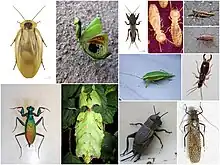Polyneoptera
The cohort Polyneoptera[1][2] is a proposed taxonomic ranking for the Orthoptera (grasshoppers, crickets, etc.) and all other Neopteran insects believed to be more closely related to Orthoptera than to any other insect orders. These winged insects, now in the Paraneoptera, were formerly grouped as the Hemimetabola or Exopterygota on the grounds that they have no metamorphosis, the wings gradually developing externally throughout the nymphal stages.[3]
| Polyneoptera | |
|---|---|
 | |
| Some representatives | |
| Scientific classification | |
| Domain: | Eukaryota |
| Kingdom: | Animalia |
| Phylum: | Arthropoda |
| Class: | Insecta |
| Subclass: | Pterygota |
| Branch: | Metapterygota |
| Infraclass: | Neoptera |
| Cohort: | Polyneoptera Martynov, 1938 |
| Orders | |
| Synonyms | |
| |
Taxonomy
The Polyneoptera Species File lists the following:[4]
Superorder Dermapterida
Superorder Dictyoptera
Superorder Orthopterida
Synonyms include: Archaeorthoptera, Gryllidea, Orthopterodea, Orthopterodida, Orthopteroidea, Panorthoptera
- †Caloneurodea
- †Geraroptera
- Orthoptera – 2 extant suborders:
- †Titanoptera – Carboniferous to Triassic
- order Incertae sedis
- family †Cacurgidae Handlirsch, 1911
- family †Chresmodidae Haase, 1890
- family †Permostridulidae Béthoux, Nel, Lapeyrie & Gand, 2003
- family †Protophasmatidae Brongniart, 1885
- genus †Chenxiella Liu, Ren & Prokop, 2009
- genus †Lobeatta Béthoux, 2005
- genus †Nectoptilus Béthoux, 2005
- genus †Sinopteron Prokop & Ren, 2007
Superorder Perlidea (synonym Plecopteroidea)
- †Cnemidolestida[5]
- Dermaptera – earwigs
- Embioptera – web-spinners
- †Eoblattida
- Plecoptera – stone-flies
- †"Grylloblattida"
- †Geinitziidae
- †Juraperlidae
- †Bajanzhargalanidae
- Grylloblattodea – ice-crawlers
- Mantophasmatodea – gladiators
- †Protorthoptera
Stem-Phasmatodea
- †family Xiphopteridae Sharov 1968
- †family Prochresmodidae Vishnyakova 1980
- †family Aeroplanidae Tillyard 1918
- † family Cretophasmatidae Sharov 1968
- † family Aerophasmatidae Martynov, 1928
- Phasmatodea – stick and leaf insects
Phylogeny
Song et al 2016 proposed a molecular phylogeny for the Polyneoptera, as shown in the phylogenetic tree:[7]
| Polyneoptera |
| ||||||||||||||||||||||||||||||||||||||||||||||||||||||
References
- Martynov, AV (1938). "Studies on the geological history and phylogeny of the orders of insects (Pterygota)". Tr. Paleont. Inst. Inst. Akad. Nauk SSSR (in Russian). 7 (4): 70.
- Delclos; Nel; Azar; Bechly; Dunlop; Engel; Heads (2008). "The enigmatic Mesozoic insect taxon Chresmodidae (Polyneoptera): New palaeobiological and phylogenetic data, with the description of a new species from the Lower Cretaceous of Brazil". Neues Jahrbuch für Geologie und Paläontologie - Abhandlungen. 247 (3): 353–381. doi:10.1127/0077-7749/2008/0247-0353.
- Entomology Endopterygota. Royal Entomological Society. Retrieved 29 September 2020.
- Polyneoptera, Species File (Version 5.0/5.0; retrieved 5 September 2020)
- Aristov, D. (2014). "Classification of the order Cnemidolestida (Insecta: Perlidea) with descriptions of new taxa". Far Eastern Entomologist. 277: 1–46.
- Yang, Hongru; Shih, Chungkun; Rasnitsyn, Alexandr P.; Ren, Dong; Gao, Taiping (January 2022). Labandeira, Conrad (ed.). "Early Cretaceous enigmatic insect group showing unique wing venations and antennal sensilla". Papers in Palaeontology. 8 (1). doi:10.1002/spp2.1402. ISSN 2056-2799.
- Song, Nan; Li, Hu; Song, Fan; Cai, Wanzhi (26 October 2016). "Molecular phylogeny of Polyneoptera (Insecta) inferred from expanded mitogenomic data". Scientific Reports. 6 (1). doi:10.1038/srep36175. ISSN 2045-2322.
External links
 Media related to Polyneoptera at Wikimedia Commons
Media related to Polyneoptera at Wikimedia Commons